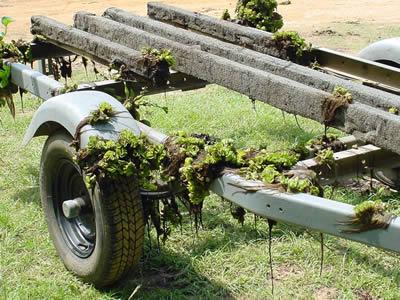
February 9, 2018 - Thanks to the sharp eye and fast action of a local fisherman, Texas Parks and Wildlife's aquatic invasive species crews say they will be able to get an early jump start in stamping out a Giant Salvinia infestation recently discovered at Lake Nacogdoches in eastern Texas.
The discovery was made on Jan. 30 by bass angler, Tommy Hamilton. Hamilton said was fishing in the Yellow Bank Creek arm of the 2,200-acre lake when he noticed a small plant floating on the surface. He said the plant looked familiar, but out of place.
"It was about 15-20 feet from my boat," Hamilton said. "At first I thought no way, but once I picked it up I knew what it was. I've seen a bunch of it on Lake Naconiche and the Angelina River, so I know what it looks like."
Hamilton placed a sample of the plant in a water bottle. Photos were subsequently sent to TPWD fisheries biologist Todd Driscoll and John Findeisen, TPWD invasive species biologist. Both scientists confirmed the plant as Giant Salvinia, an aquatic fern that as been found in a number of lakes across East Texas over the last 20 years.
Giant salvinia was first discovered on Toledo Bend in 1998 and has since spread throughout East Texas. In addition to current infestations at Toledo Bend, Sam Rayburn, Caddo Lake and Lake Naconiche, TPWD says the invasive plant has been newly introduced or reintroduced at five East Texas lakes since last fall. Among them are Lake Murvaul, Lake Palestine, Martin Creek, Lake Fork and, most recently, Lake Nacogdoches.
Driscoll said this marks the first time the plant has been found at Lake Nacogdoches. He and other TPWD staff surveyed the Yellow Bank Creek arm of the lake less than 24 hours after confirming the discovery from the photo. He said they used dip nets to recover enough floating plants to fill several five-gallon buckets.
"There are still some plants lodged in the torpedo grass along the north bank that we just couldn't get to," Driscoll said. "Our spray crews will be going back with the air boat to spray that shoreline. Hopefully, getting the heads-up so early from that fisherman will allow us to get it under control. It could have gotten out of hand with a good growing season."
Judging from the number of plants discovered, the biologist said he believes the it was introduced to lake sometime in mid-to-late summer, more than likely from a boat trailer that was backed into the lake with live plants clinging to the bunks. He said there is a private boat ramp in Yellow Bank Creek, but fresh tire tracks off the north bank of the cove indicate that boats have been launching from the shoreline.
"That's the primary way it get spreads from one lake to another," Driscoll said. "All it takes is one little leaf to get it started."
For those who may not be familiar with Giant Salvinia, it is an alien weed with a dark history of gobbling up freshwater lakes and turning them into aquatic deserts. Once established, it can spread at a rate so fast that it can double in coverage area in a week or less.
Left unchecked, giant salvinia can devastate to a watery ecosystem by forming a surface canopy so dense that sunlight cannot penetrate it. The lack of sunlight sparks a chain reaction of negatives which can eventually turn a fertile body of water into a sterile one.
Lending to the plant's nasty demeanor is its ability to go mobile and infest new areas, seemingly overnight. Giant Salvinia does not root to the bottom; it floats in leafy clumps and travels where the wind takes it. The plant also fragments easily, which helps it spread like wildfire.
"A mature plant is about size of the palm or your hand with root system about inches long, but all it takes one leaf the size of a pencil eraser to get a new one started," say Ray Lenderman, a TPWD inland fisheries technician based in Jasper. "Boat motors and wave action cause it to break apart and it drifts with the wind. That's one of things that makes it so hard to control."
Another is its resiliency to the elements, even extreme cold or drought. Just a little moisture is all it needs to takes to keep it alive. Giant Salvinia thrives in warm, humid climates.









